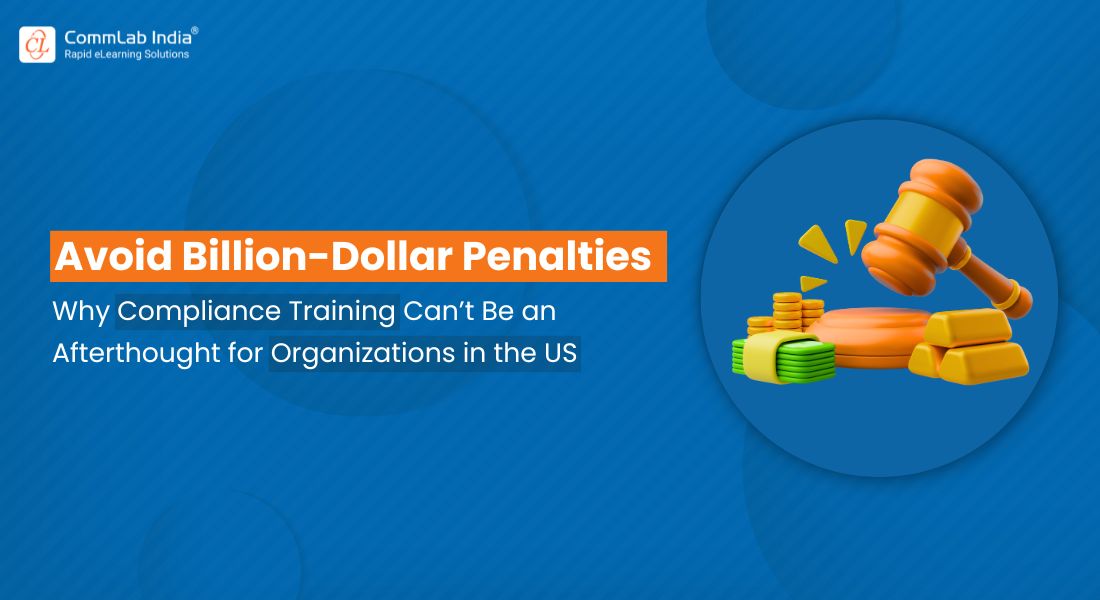Why Effective Compliance Training is the Need of the Hour for the US Workforce

Imagine facing a lawsuit that costs your company millions, or worse, billions. For too many U.S. companies, this isn’t just a nightmare; it’s a reality. Expensive legal battles, damaged reputations, and disengaged employees often stem from one common mistake: treating compliance training as a boring, one-time checkbox exercise.
With some of the world’s most rigorous regulations spanning workplace safety, data privacy, and anti-discrimination laws, the U.S. demands a proactive approach to compliance. In today’s landscape of regulatory complexity, digital transformation, and increased social accountability, compliance training must evolve. It should shift from dry, generic legal jargon to dynamic, role-specific training that truly drives behavioral change.
→ Download eBook: Advanced Instructional Design Meets AI
Table Of Content
- How is the US Regulatory Landscape?
- Where Does Compliance Training Fall Short?
- How to Create Effective Compliance Training for the US Workforce?
- What Does Compliance Training Look Like in a Post-AI Era?
The Compliance Challenge: A Moving Target
The U.S. regulatory landscape is vast, fragmented, and constantly evolving. Depending on your industry, you may be subject to a maze of compliance requirements including OSHA (Occupational Safety and Health Administration), HIPAA (Health Insurance Portability and Accountability Act), FCPA (Foreign Corrupt Practices Act), SOX (Sarbanes-Oxley Act), EEOC (Equal Employment Opportunity Commission), ADA (Americans with Disabilities Act), and others.
Pain Points: Where Compliance Training Fails
So why do so many compliance training initiatives fall flat? Let’s break down the most common missteps:
1. One-Size-Fits-All Training
Not all employees face the same compliance challenges, yet many training programs treat everyone as if they do. For example, a warehouse worker likely doesn’t need in-depth anti-bribery; that is more relevant for your global finance teams. But when training fails to account for these differences, it delivers generic content that feels out of touch and irrelevant. This disconnect leaves employees frustrated and disengaged, making it harder for them to take compliance seriously.
The stakes are too high for outdated slide decks or generic eLearning modules.
Here's why your organization needs to choose custom eLearning solutions!
2. Overload Without Context
Bombarding employees with rules and regulations can be overwhelming, especially when there’s no effort to explain why those rules matter. Sure, they might memorize a policy or two, but without real-world examples, the information doesn’t stick. People need to understand how compliance applies to their day-to-day work. Without context, training becomes just another task to check off a list, rather than something that sparks behavior change.
3. No Follow-Up or Reinforcement
Even the most engaging training session won’t have a lasting impact if it’s treated as a one-and-done event. People forget things; it’s human nature. If there’s no follow-up or ongoing reinforcement, the knowledge fades quickly. And considering how fast laws and risks evolve, relying on one annual workshop to cover everything just isn’t realistic. This lack of continuity leaves employees unprepared to handle new challenges as they arise.
4. Lack of Data and Accountability
How do you know if your compliance training is actually working? Many companies don’t. Without data on who’s engaging with the material, where knowledge gaps exist, or which roles are most at risk, it’s nearly impossible to measure the impact of your compliance training program. This lack of accountability creates blind spots, leaving businesses vulnerable to compliance failures simply because they don’t know where they’re falling short.
Solution: Build Smarter, Stronger Compliance Training for the US Workforce
How to Deliver Effective Compliance Training for the U.S. Workforce
Here's how to get it right:
- Design Role-Specific Training Paths
- Embed Real-World Scenarios
- Leverage Technology for Reinforcement
- Track, Analyze, and Report Progress
- Build a Culture of Compliance, Not Fear
Effective compliance training in the U.S. needs to be customized, continuous, and compliance-grade. Here’s how to do it:
1. Design Role-Specific Training Paths
Map out training content by department, risk exposure, and job role. HR teams need deep dives into EEOC and FMLA; IT staff should master data privacy (CCPA, GDPR); and leadership must understand SOX and FCPA obligations.
Custom eLearning solutions can enhance this process by tailoring training programs to your organization’s unique needs. These solutions allow you to create interactive, engaging content that aligns with specific compliance requirements, ensuring employees retain critical information while staying on track with regulatory obligations.
Say goodbye to the one-size-fits-all approach—discover how adaptive courses transform compliance training for better engagement and results.
Bonus Tip: Use microlearning to deliver short, focused content that fits into busy workflows.
2. Embed Real-World Scenarios
Learners respond best to contextual training. Add case studies or simulations in eLearning courses based on American workplace culture and regulatory triggers.
For example, design eLearning modules that reflect scenarios rooted in the workplace culture, including common practices, ethical dilemmas, or regulatory requirements. By providing contextually relevant examples, learners can better understand how to apply their knowledge in practical situations, making the training more effective and impactful.
3. Leverage Technology for Reinforcement
To ensure compliance becomes a natural part of daily routines, utilize technology-driven tools that reinforce key rules effectively. Spaced repetition techniques can help employees retain critical information over time by revisiting concepts at strategic intervals.
PwC’s L&D Academy emphasizes reinforcement tools (digital follow-up after classroom or live sessions) to ensure true skill application.
Mobile nudges, such as push notifications or prompts, can serve as gentle reminders to follow best practices or revisit important guidelines. Additionally, Learning Management Systems (LMS) can be programmed to send alerts or reminders, while chatbots can provide real-time support, answering compliance-related questions as they arise. Microlearning courses are another powerful tool, delivering bite-sized lessons, making it easier to embed compliance behaviors into their daily workflows. By integrating these technologies, organizations can create a seamless, consistent reinforcement process that supports long-term adherence to compliance requirements.
Bonus Tip: Consider adaptive learning that personalizes content based on past performance.
Discover how spaced learning can help learners overcome the forgetting curve and boost their memory!
4. Track, Analyze, Report
Use your LMS to generate audit-ready reports.
Track:
- Completion rates
- Quiz scores by risk domain
- Departmental compliance readiness
- Incident correlation (e.g., training effectiveness vs. policy breaches)
This helps prepare for audits from regulators like the DOJ, OSHA, or HHS.
5. Build a Culture of Compliance, Not Fear
Reframe compliance as empowerment, not punishment. Celebrate training milestones. Recognize ethical decision-making. Encourage anonymous reporting without fear of retaliation.
When employees view compliance as protection rather than a policing mechanism, they engage more deeply.

Advanced Instructional Design Meets AI
- Modern instructional strategies
- Top Gen AI tools in action
- Case studies, tips, and tricks
- And More!
Future-Forward: Designing Compliance Training in a Post-AI Era
AI is changing everything, and compliance is no exception.
Compliance training must now address:
- AI ethics and accountability
- Algorithmic bias
- Data security beyond HIPAA (think biometrics, facial recognition)
Automated reporting, AI-aided monitoring, and agentic learning experiences will soon become the norm. However, human-centered instructional design remains the foundation of truly impactful learning experiences. When it comes to designing custom eLearning courses, especially for critical areas like compliance training, the role of skilled instructional designers is irreplaceable. Their ability to tailor content, structure, and delivery to meet specific learner needs ensures that training is not only effective but also engaging.
With the integration of AI tools, instructional designers can now elevate their work to new heights, analyzing learner behavior, personalizing content, and automating repetitive tasks to focus on creativity and strategy. This synergy between human expertise and AI innovation promises a future where compliance training is not just a checkbox exercise but a transformative learning experience.
Wrapping Up!
Compliance training is the backbone of a successful, resilient business. A well-trained team can help you avoid costly mistakes, build trust with clients, and foster a stronger workplace culture. But as discussed above, here’s the key: one-size-fits-all training doesn’t cut it anymore. That’s where custom eLearning courses come in. They’re tailored to your organization’s unique needs, making learning more engaging, relevant, and impactful for your team.
Ready to level up your compliance training and design strategies that truly work? Download our free eBook and discover the power of AI-powered instructional design that creates compliance training courses which make a real difference.






![6 Tips to Make Compliance Training Fun and Exciting [Infographic]](https://blog.commlabindia.com/hubfs/blogs/compliance-training-making-engaging-infographic.jpg)

